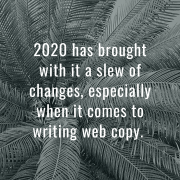2020 has brought with it a slew of changes, especially when it comes to writing web copy. Here are 5 of the more popular ones.
The modern web copy in 2020 has undergone a flurry of changes. Not keeping up with these developments is a sure-fire way of sinking your marketing budget. It is worth noting that we’re not reinventing the wheel here, not so much as fine-tuning the rules of web copywriting.
An effectively written web copy has the power to yield huge returns on time and money. A badly written web copy is the easiest way to send prospective clients away from your website and therefore, your products.

Table of Contents
So what has changed in 2020?
1. Fleeting attention spans
Studies by Microsoft made a startling discovery. Online users have a tiny attention span of less than 8 seconds. To put things in perspective, a goldfish has a higher attention span. The reason we’re so distracted is that we’re constantly bombarded with too much information that overwhelms – shorter attention spans is a way of coping in the age of mass-communication.
As a result, our brains give prospective products 8 seconds to win us over… or we’ll just bailout. This is where an effective web copy comes in. The first few words can either push us away or welcome us in. They should ideally address our pain points and empathize with us. A web copy can be funny and relatable if the subject matter warrants it.
Being funny, and sometimes, satirical is a sure-fire way of succeeding online. The goal of any web copy is to first and foremost, delight, inspire, and intrigue the online user. Just take one look at Neil Patel’s blogs (and similar popular brands) and you’ll notice a pattern – they all start with a one-sentence liner. It’s usually funny and witty while being informational.
2. The need for statistics
Once you have roped in your users with the opening, it’s time to legitimize your web copy by tossing in the right dose of numbers and data. Make sure the statistics are linked back to an authority on the subject. This is a great way to add credibility to your work and will give a strong foundation to the rest of your pitch. If at all possible, try to include infographics.
In fact, an infographic is 30 times more likely to be read than a textual article. See what we did right here? Statistics will help you sell more products and services. Use them where relevant.
Make sure to strike a healthy balance with numbers. Too less and you’ll not appear credible enough when making certain claims, too many and you’ll overwhelm them with numbers. You can hire experienced copywriting services to help you identify the sweet spot when it comes to statistics and data.
3. Prioritizing Infographics
Speaking of infographics, use them to make a point. Infographics become especially useful if you’ve got a lot of numbers to share and need to present them in as few words as possible. The infographic should make use of various visual cues and colours to explain what each number and percentage means. The ideal infographics should also feature subheadings to break up the content into bite-sized pieces.
Since you’ll be using fewer words here, make sure to add strong verbs that evoke emotion and captivate audiences. Weak verbs simply won’t spice up your text and will dilute the hype generated by the statistics you just added.
To further simplify your infographic copy, make sure to leave room for white space, also known as negative space. This is also known as the area around infographic elements. The last thing you need is to clump up all the visual elements together. That makes your infographic too busy and difficult to follow.
4. Don’t act like a know-it-all
Here’s an unspoken rule of writing web copy: never try to sell yourself as a know-it-all. Your goal is to simplify things to the point that a 5th grader can easily understand things. Bulky words will alienate your audiences and make you sound too pompous and self-important. More importantly, your readers will lose any focus and attention; this means that all your hard work in Steps 1, 2, and 3 will come undone.
Now we’re not asking you to completely dumb down the web copy, just get rid of the jargon. You may want to use an editor like Grammarly to evaluate the Flesch rating of your article. A Flesch score of 90 to 80 is known as conversational English and is the easiest for consumers to follow. Any lower than that and you start losing audience interest.
Remember, you’re not writing a research paper – you’re pitching your product or service to your audience.
5. Optimize the web copy for voice search
A growing body of data indicates that 50% of all searches will be based on the voice in 2020. Voice search has become one of the most important pillars of SEO. It has been popularized thanks to smartphones with their microphones. Users can simply whip up their phones and speak their minds into Google (or other search engines). Most users find this to be a faster way to search for information online.
It is important to note that people speak and type very differently. Suppose you’re searching for a mechanical keyboard online. There are two ways to search for the topic online:
Typing on a search engine: “best mechanical keyboard in Ohio”
Using voice search: “What is the best mechanical keyboard for me in Ohio?”
Not only is the latter more conversational but it also indicates an intent for purchase. If you are designing a web copy for mechanical keyboards in Ohio, you’ll want to optimize the copy around voice search. Answer the Public is one popular tool that lets you discover what people are ‘speaking’ most frequently about.
Continue Reading: Web Content Copywriting for Newbies
About the Author:
Dave handles a team of web copywriters at Content Development Pros. He has worked alongside Fortune 500 companies and SMEs alike, growing their business with unique content services. When he’s not busy working on blogs and web copies, Dave can be found browsing the internet for fun and watching YouTube.



 ArticleWriting-copywritercollective
ArticleWriting-copywritercollective  Advertising-trends-copywritercollective
Advertising-trends-copywritercollective  WordPress-copywritercollective
WordPress-copywritercollective 

